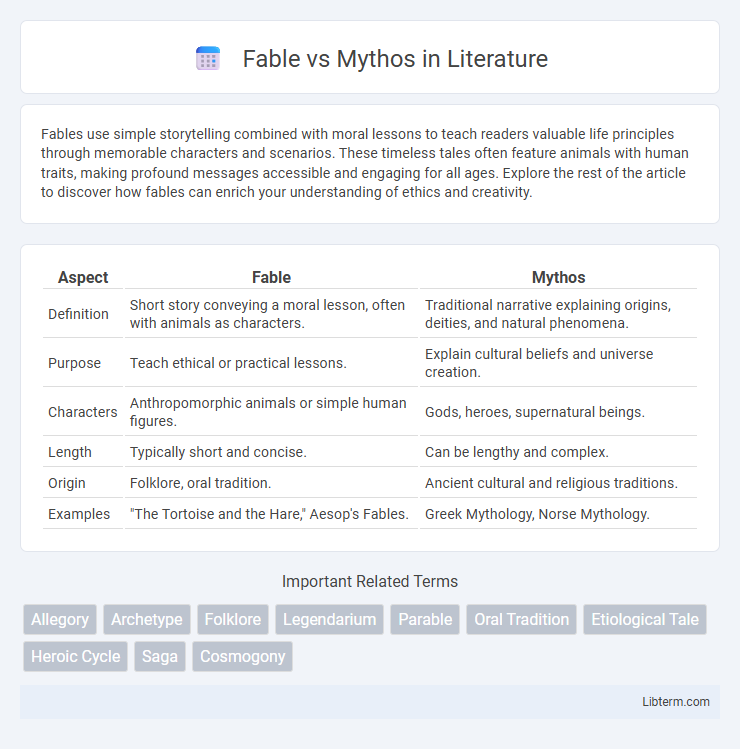Fables use simple storytelling combined with moral lessons to teach readers valuable life principles through memorable characters and scenarios. These timeless tales often feature animals with human traits, making profound messages accessible and engaging for all ages. Explore the rest of the article to discover how fables can enrich your understanding of ethics and creativity.
Table of Comparison
| Aspect | Fable | Mythos |
|---|---|---|
| Definition | Short story conveying a moral lesson, often with animals as characters. | Traditional narrative explaining origins, deities, and natural phenomena. |
| Purpose | Teach ethical or practical lessons. | Explain cultural beliefs and universe creation. |
| Characters | Anthropomorphic animals or simple human figures. | Gods, heroes, supernatural beings. |
| Length | Typically short and concise. | Can be lengthy and complex. |
| Origin | Folklore, oral tradition. | Ancient cultural and religious traditions. |
| Examples | "The Tortoise and the Hare," Aesop's Fables. | Greek Mythology, Norse Mythology. |
Understanding Fables and Mythos: Key Definitions
Fables are concise narrative tales featuring anthropomorphic characters that convey moral lessons, often targeting children and emphasizing ethical teachings. Mythos refers to a broader body of traditional stories or myths that explain natural phenomena, cultural practices, and historical events, embodying the collective beliefs and values of a society. Understanding the distinction between fables and mythos involves recognizing fables as didactic short stories and mythos as complex, culturally significant narratives shaping worldviews.
Origins and Historical Context of Fables vs Mythos
Fables originated as short moral stories frequently attributed to ancient storytellers like Aesop, serving educational purposes across cultures by conveying ethical lessons through animals or personified characters. Mythos, rooted in the ancient Greek term for "story" or "myth," encompasses expansive narratives explaining natural phenomena, gods, and cultural origins, reflecting the worldview and spiritual beliefs of early civilizations. Historically, fables functioned primarily as didactic tools in oral traditions, while mythos developed as complex mythologies central to religious and cultural identity.
Core Purposes: Morality Lessons vs World-Building
Fables serve a core purpose of imparting morality lessons by using concise narratives featuring anthropomorphic characters to illustrate ethical principles. Myths focus on world-building, providing expansive stories that explain natural phenomena, origins, and cultural beliefs, often involving gods and heroes. The primary distinction lies in fables aiming to teach practical virtues, while myths construct foundational cosmologies and societal values.
Narrative Structure and Plot Elements
Fable employs a straightforward narrative structure with concise plot elements centering on moral lessons, featuring anthropomorphic characters and clear cause-and-effect sequences. Mythos presents a complex narrative structure rich with symbolic plot elements, including epic quests, divine interventions, and multifaceted character arcs reflecting cultural values and existential themes. Both narrative types use storytelling to convey foundational truths but differ in complexity, scope, and cultural depth.
Character Types: Animals, Deities, and Humans
Fable narratives primarily feature anthropomorphic animals embodying distinct human traits, serving as moral exemplars or warnings within concise tales. Mythos centers on deities and supernatural beings whose complex interactions with humans reveal cultural beliefs, creation stories, and existential themes. Both genres portray humans either as protagonists or observers, highlighting ethical lessons in fables and epic journeys or divine interventions in myths.
Cultural Significance Across Civilizations
Fable and mythos each hold profound cultural significance across civilizations, with fables often serving as moral instruction through allegorical tales featuring animals or humans, while mythos encompasses broader mythological narratives explaining cosmic origins, deities, and natural phenomena. Fables like Aesop's have disseminated ethical values universally, shaping social norms, whereas mythos such as Greek or Norse myths have preserved collective identity and religious beliefs, influencing art, literature, and ritual practices. Both forms contribute to cultural heritage by encoding societal values, worldviews, and existential questions within their respective storytelling frameworks.
Symbolism and Allegory in Fable and Mythos
Fables use simple symbolism and clear allegories to convey moral lessons, often featuring anthropomorphic animals representing human virtues and vices. Myths employ complex symbolism and multifaceted allegories that explore fundamental human experiences, natural phenomena, and cosmic principles, frequently involving gods and heroic figures. The symbolic content in myths tends to be more layered, reflecting cultural beliefs and existential themes beyond the straightforward moral messages typical of fables.
Transmission: Oral Tradition to Written Literature
Fables originated primarily through oral tradition, passed down verbally across generations, often featuring animals and moral lessons that were easily memorable and adaptable. Myths also began as oral narratives deeply rooted in cultural rituals and religious beliefs, serving to explain natural phenomena and human origins before being codified in ancient texts. The transition from oral to written literature allowed both fables and myths to be preserved, standardized, and disseminated widely, with key examples including Aesop's fables and Hesiod's Theogony.
Influence on Modern Storytelling and Media
Fables, characterized by their moral lessons and anthropomorphic characters, have profoundly shaped modern storytelling by providing clear ethical frameworks woven into engaging narratives. Myths, with their rich symbolism and exploration of human origins and cosmic order, influence contemporary media by inspiring complex world-building and archetypal characters in literature, film, and video games. Both genres contribute foundational structures and timeless themes that continue to resonate in popular culture and creative industries worldwide.
Enduring Legacy in Contemporary Society
Fable and mythos maintain an enduring legacy in contemporary society by shaping cultural identity and moral frameworks across generations. Their narratives continue to influence literature, film, and education, embedding timeless themes of heroism, morality, and human nature into modern storytelling. The persistent relevance of archetypal characters and motifs in popular media underscores the deep-rooted impact of these traditional narratives on collective consciousness.
Fable Infographic

 libterm.com
libterm.com